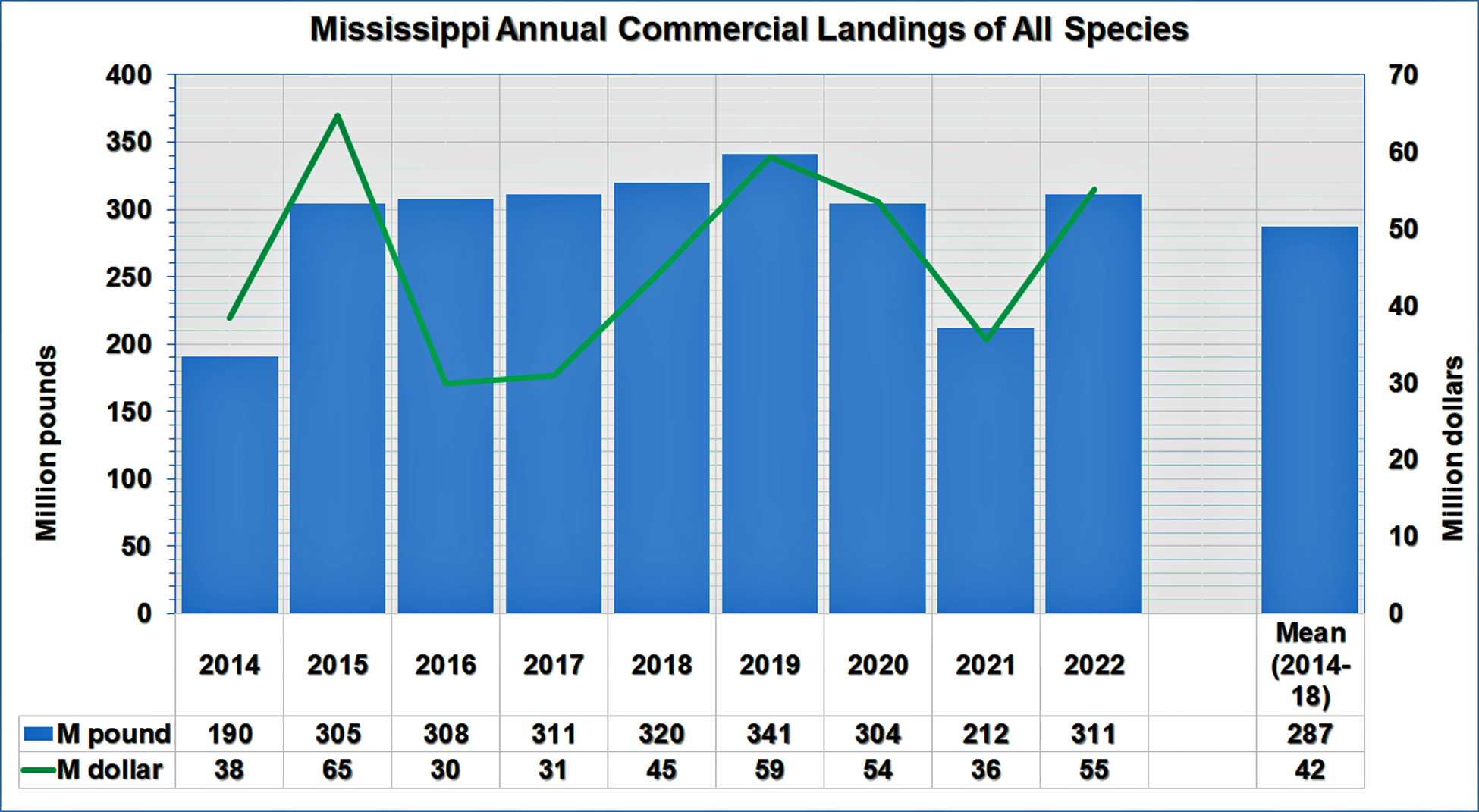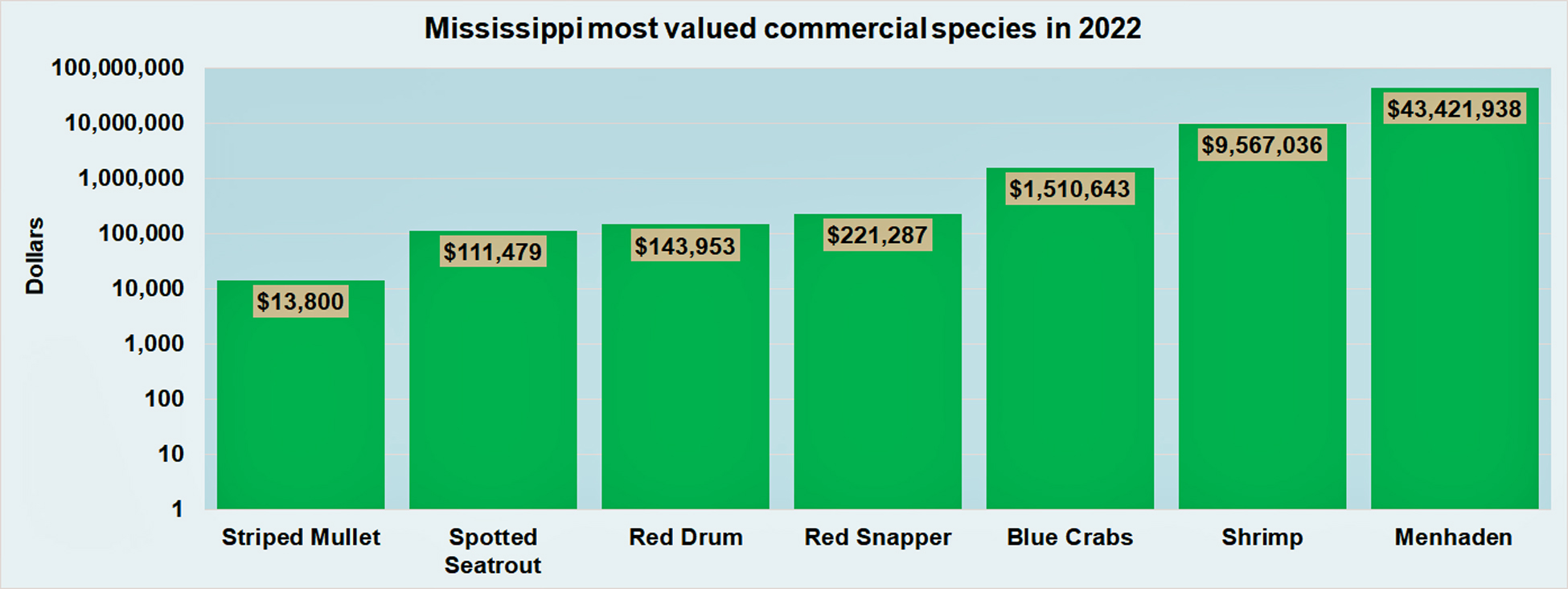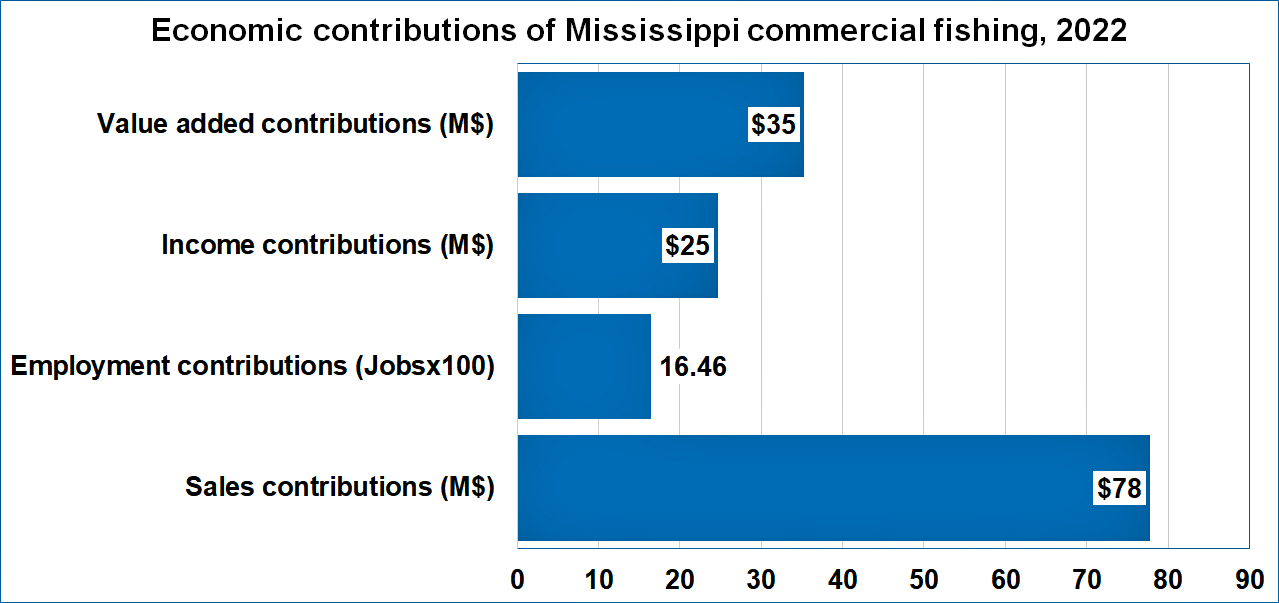Vol. 14, No. 8 / Economic Contributions of the Mississippi Commercial Fishing
ABSTRACT
This newsletter provides a detailed summary of the most recent estimates of the economic contributions of Mississippi commercial fishing.
KEYWORDS
Economic contribution; Mississippi commercial fishing; fishers and owners
ACKNOWLEDGEMENT
This newsletter is a contribution of the Mississippi Agricultural and Forestry Experiment Station and the Mississippi State University Extension Service. This material is based upon work that is supported in part by the National Institute of Food and Agriculture, U.S. Department of Agriculture, Hatch project under accession number 081730, and Mississippi-Alabama Sea Grant Consortium using federal funds under Grant NA24OAR4170090 from the National Sea Grant Office, NOAA, U.S. Dept. of Commerce. The statements, findings, conclusions, and recommendations are those of the author and do not necessarily reflect the views of the National Sea Grant Program, NOAA, U.S. Department of Commerce. This newsletter is a Mississippi-Alabama Sea Grant Publication number MASGP-24-057-08.
COMPONENTS OF COMMERCIAL FISHING
- Commercial fishing corresponds to finfish and shellfish fishing in the North American Industrial Classification System (NAICS).
- Finfish fishing comprises establishments primarily engaged in the commercial catching or taking finfish (e.g., menhaden, redfish, snapper, seatrout, flounder, mullet, and sheepshead) from their natural habitat.
- Shellfish fishing comprises establishments primarily engaged in the commercial catching or taking shellfish (e.g., blue crab, oyster, shrimp) from their natural habitat.
COMMERCIAL LANDINGS AND DOCKSIDE VALUES
- Recent natural and man-made disasters, economic recession, and the global pandemic adversely affected commercial landings and dockside values.
- The commercial landings averaged 287 million pounds during the selected benchmark period, valued at $42 million.
- The commercial landings and dockside values seemed to have fallen during the pandemic years.
- Total commercial landings were 341 million pounds in 2019, valued at over $59 million.
- In 2020, commercial landings reached 304 million pounds, valued at over $54 million.
- Commercial landings and dockside values in 2021 were significantly lower than the benchmark values in 2014-18.
- Total commercial landings reached 311 million pounds in 2022, valued at over $55 million.
- Since 2019, no commercial landings of oysters were reported in Mississippi. The public oyster reefs were decimated during the massive and prolonged freshwater intrusions in 2019.

MOST VALUED COMMERCIAL SPECIES
- There are four types of economic impacts – output or sales, jobs, income, and value-added. These impacts are not additive. Each type represents a specific economic activity reported.
- Income, value-added, and output impacts are expressed in dollars for the year specified by the user.
- Output or sales are the gross sales by businesses within the economic region affected by an activity.
- Labor income includes personal income such as wages and salaries and proprietors' income or income from self-employment.
- Employment impacts are expressed in terms of a mix of both full-time and part-time jobs.
ECONOMIC CONTRIBUTIONS OF MISSISSIPPI SEAFOOD INDUSTRY
- The figure below shows the most valued species landed by Mississippi commercial fishermen in 2022.
- Menhaden was the most valued species, valued at $43.4 million or 78.7 percent of the total landing values.
- The combined brown and white shrimp landings added $9.5 million, or 17.3 percent.
- Blue crabs came in third most valued species with $1.5 million in dockside sales or 2.7 percent.
- Red snapper, red drum, spotted seatrout, and striped mullet added 1.3 percent to the total dockside values in 2022.

COMPONENTS OF ECONOMIC IMPACTS (IMPLAN, 2024)
- The total economic impact is the sum of direct, indirect, and induced impacts.
- Direct impacts express the economic impacts in the sector where the expenditure was initially made.
- Indirect impacts result from changes in the economic activity of other industrial sectors that supply goods or services to the sector being evaluated.
- Induced impacts are the result of industry employees' personal consumption expenditures.
TYPES OF ECONOMIC IMPACTS (IMPLAN, 2024)
- There are four types of economic impacts – output or sales, jobs, income, and value-added. These impacts are not additive. Each type represents a specific economic activity reported.
- Income, value-added, and output impacts are expressed in dollars for the year specified by the user.
- Output or sales are the gross sales by businesses within the economic region affected by an activity.
- Labor income includes personal income such as wages and salaries and proprietors' income or income from self-employment.
- Employment impacts are expressed in terms of a mix of both full-time and part-time jobs.
- Value added contribution measures an industry's contribution to the gross domestic product. It is the difference between an Industry's total output and the costs of its intermediate inputs.
- The income contribution of commercial fishing reached $24 million. Labor income consists of all forms of employment income, including employee compensation -- wages, salaries, and benefit and proprietor income.
ECONOMIC CONTRIBUTIONS OF MISSISSIPPI COMMERCIAL FISHING INDUSTRY
- Commercial fishing generated economic activities and provided jobs in the coastal counties.
- Commercial fishing produced $78 million in sales in 2022. This amount represents 24% of the total sales contributions of the seafood industry in Mississippi.
- Commercial fishing created 1,646 full-time and part-time jobs in 2022, contributing about 24% of the overall jobs contributions of the seafood industry in Mississippi.
- Commercial fishing generated $25 million in labor income in 2022. This income represents about 19% of the total sales contributions of the seafood industry in Mississippi.
- Commercial fishing generated $35 million in value added in 2022, adding about 21% of the overall value-added contributions of the seafood industry in Mississippi.

SOCIO-DEMOGRAPHIC PROFILES OF MISSISSIPPI COMMERCIAL FISHERMEN AND OWNERS
- Annual data from Lightcast (2024) indicate more than 1,300 Mississippi commercial fishermen and owners.
- About 10.5 percent are women.
- Three-fourths are White, 7.1 percent are African Americans, 10.6 percent are Hispanic, and 3.6 percent have two or more races.
- The rest are Asians, American Indians, and Native Hawaiians.
- The average age of Mississippi commercial fishermen and owners was 43 years old.
- About 24 percent were less than 34 years old.
- About 54 percent were between 35 and 54 years old.
- The 55-year-old and higher commercial fishermen and owners comprised 22 percent.
CONCLUSIONS, LIMITATIONS, AND IMPLICATIONS
- The Mississippi commercial fishing industry produced about $78 million in total sales impacts in 2022.
- The Mississippi commercial fishing industry created 1,646 jobs in 2022.
- Natural, technological, and man-made disasters severely impacted the Mississippi commercial fishing industry in 2005, 2010, 2011, and 2019.
- The Mississippi commercial fishing industry suffered from the negative impacts of the COVID-19 pandemic and has not yet fully recovered.
- Although not presented here, the openings of the Bonnet Carre Spillway in 2019 have severely impacted specific components of the Mississippi commercial fishing industry.
SUGGESTED CITATION
Posadas, Benedict C. 2024. Economic Contributions of Mississippi Commercial Fishing. Mississippi MarkeMaker Newsletter, Vol. 14, No. 8. Mississippi State University Extension and Mississippi-Alabama Sea Grant Publication number MASGP-24-057-08. August 20, 2024. https://extension.msstate.edu/newsletters/mississippi-marketmaker.
For accessibility assistance please contact Ben Posadas at [email protected]









